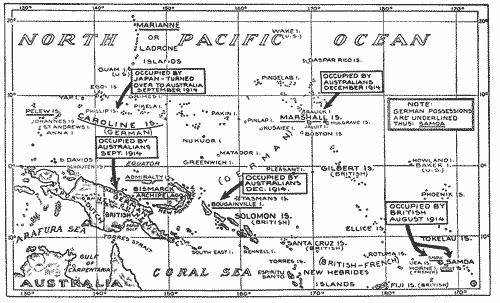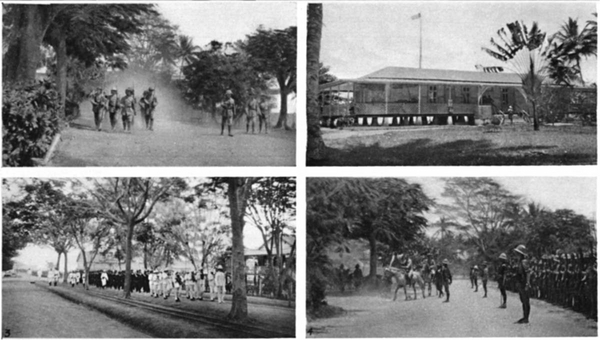 the Archive of World War 1 Photographs and Texts
the Archive of World War 1 Photographs and Texts

Germany's Pacific Territories
In addition to the populous province of Kiaochow and the City of Tsingtao in China, Germany controlled several minor islands in the Pacific. These were: German Samoa · German New Guinea (German Solomon Islands • German Marshall Islands) · Caroline Islands · Mariana Islands · Nauru · Palau

Map Showing German Possessions in the Pacific Islands
Britain, Japan, and Australia moved quickly to seize these German territories. Shortly after the outbreak of War Australia occupied the Solomon Archipelago (an area of 18,000 square miles and at the time 200,000 inhabitants) as well as German New Guinea. New Zealand occupied German Samoa. Japan seized the Marianas and Palau.
Little German resistance was offered on land. However German surface raiders continued to harass Allied shipping. The German cruisers Scharnhorst and Gneisenau continued to operate in the Pacific, bombarding the French colony of Papeete on the island of Tahiti in 1914, and inflicting much damage, including the sinking of two vessels. The German cruisers also sank Allied troop ships and defeated a weaker Allied cruiser squadron in the Battle of Coronel. The German ships eventually entered the South Atlantic and were part of the German naval squadron that was defeated by the British at the Battle of the Falklands, off the coast of Argentina.

|
|
The Admiralty announced on September 13 that the Australian Squadron had occupied, on the 11th, "the town of Herbertshöhe, in the island of Neu Pommern (late New Britain), which is an island in the Bismarck Archipelago; this island lies due east from German New Guinea." At Rabaul, New Britain, on the 13th, a British Proclamation was read, with a special one in "Pidgin English" (References: Pidgin/English Dictionary) for the natives. The German Acting-Governor, Dr. Haber, surrendered on the 21st. Our photographs show: (1) German troops marching into Herbertshöhe to surrender; (2) A German building at Friedrich Wilhelmshafen, now garrison headquarters; (3) The Australian Naval Brigade marching through Rabaul; and (4) Dr. Haber, followed by the German Commander, riding into Herbertshöhe to surrender. |
The acquisition of the German islands and Chinese territories by the Japanese was to play a role in Japan's subsequent war with China and the United States during World War 2. Many of the bases acquired by the Japanese were used by them to launch their offensives during World War 2.
For the most part, military operations (both land and sea) in the Pacific region played a very minor role in the outcome of the War. While the German colonies in the Pacific were easily subdued by the Allies, much heavier fighting would take place in the German colonies in Africa.